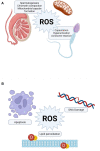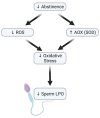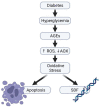Oxidative Stress and Male Infertility: Evidence From a Research Perspective
- PMID: 36303652
- PMCID: PMC9580735
- DOI: 10.3389/frph.2022.822257
Oxidative Stress and Male Infertility: Evidence From a Research Perspective
Abstract
Male fertility potential can be influenced by a variety of conditions that frequently coincide. Spermatozoa are particularly susceptible to oxidative damage due to their limited antioxidant capacity and cell membrane rich in polyunsaturated fatty acids (PUFAs). The role of oxidative stress (OS) in the etiology of male infertility has been the primary focus of our Stellenbosch University Reproductive Research Group (SURRG) over the last 10 years. This review aims to provide a novel insight into the impact of OS on spermatozoa and male reproductive function by reviewing the OS-related findings from a wide variety of studies conducted in our laboratory, along with those emerging from other investigators. We will provide a concise overview of the production of reactive oxygen species (ROS) and the development of OS in the male reproductive tract along with the physiological and pathological effects thereof on male reproductive functions. Recent advances in methods and techniques used for the assessment of OS will also be highlighted. We will furthermore consider the current evidence regarding the association between OS and ejaculatory abstinence period, as well as the potential mechanisms involved in the pathophysiology of various systemic diseases such as obesity, insulin resistance, hypertension, and certain mental health disorders which have been shown to cause OS induced male infertility. Finally, special emphasis will be placed on the potential for transferring and incorporating research findings emanating from different experimental studies into clinical practice.
Keywords: diabetes mellitus; hypertension; male infertility; obesity; oxidative stress; semen analysis.
Copyright © 2022 Ayad, Omolaoye, Louw, Ramsunder, Skosana, Oyeipo and Du Plessis.
Conflict of interest statement
The authors declare that the research was conducted in the absence of any commercial or financial relationships that could be construed as a potential conflict of interest.
Figures





Similar articles
-
Role of oxidative stress in female reproduction.Reprod Biol Endocrinol. 2005 Jul 14;3:28. doi: 10.1186/1477-7827-3-28. Reprod Biol Endocrinol. 2005. PMID: 16018814 Free PMC article. Review.
-
[Utility of oxidative stress test in the male infertility clinic].Zhonghua Nan Ke Xue. 2002;8(1):1-9. Zhonghua Nan Ke Xue. 2002. PMID: 12479038 Chinese.
-
Role of reactive oxygen species in male infertility.Urology. 1996 Dec;48(6):835-50. doi: 10.1016/s0090-4295(96)00313-5. Urology. 1996. PMID: 8973665 Review.
-
Autophagy is activated in human spermatozoa subjected to oxidative stress and its inhibition impairs sperm quality and promotes cell death.Hum Reprod. 2022 Apr 1;37(4):680-695. doi: 10.1093/humrep/deac021. Hum Reprod. 2022. PMID: 35137097
-
Role of isoprostanes in human male infertility.Syst Biol Reprod Med. 2020 Oct;66(5):291-299. doi: 10.1080/19396368.2020.1793032. Epub 2020 Aug 25. Syst Biol Reprod Med. 2020. PMID: 32842780 Review.
Cited by
-
Paternal effects on fetal programming.Anim Reprod. 2023 Aug 28;20(2):e20230076. doi: 10.1590/1984-3143-AR2023-0076. eCollection 2023. Anim Reprod. 2023. PMID: 37700908 Free PMC article. Review.
-
From Inflammation to Infertility: How Oxidative Stress and Infections Disrupt Male Reproductive Health.Metabolites. 2025 Apr 11;15(4):267. doi: 10.3390/metabo15040267. Metabolites. 2025. PMID: 40278397 Free PMC article. Review.
-
Cytotoxic Oxidative Stress Effects of Neutrophil Extracellular Traps' Components on Cattle Spermatozoa.Antioxidants (Basel). 2024 Jun 17;13(6):733. doi: 10.3390/antiox13060733. Antioxidants (Basel). 2024. PMID: 38929172 Free PMC article.
-
The Role of Melatonin to Ameliorate Oxidative Stress in Sperm Cells.Int J Mol Sci. 2023 Oct 11;24(20):15056. doi: 10.3390/ijms242015056. Int J Mol Sci. 2023. PMID: 37894737 Free PMC article. Review.
-
Gut microbiota and male fertility: A two-sample Mendelian randomization study.Medicine (Baltimore). 2025 Feb 21;104(8):e41542. doi: 10.1097/MD.0000000000041542. Medicine (Baltimore). 2025. PMID: 39993105 Free PMC article.
References
-
- World Health Organization . WHO Fact Sheet on Infertility. (2021). Available online at: https://journals.lww.com/grh/fulltext/2021/01010/who_fact_sheet_on_infer... (accessed October 10, 2021).
-
- World Health Organization . WHO Laboratory Manual for the Examination and Processing of Human Semen, 5th ed. WHO Press (2010).
-
- Ghuman N, Ramalingam M. Male infertility. Obs Gynaecol Reprod Med. (2018) 28:7–14. 10.1016/j.ogrm.2017.10.007 - DOI
Publication types
LinkOut - more resources
Full Text Sources

